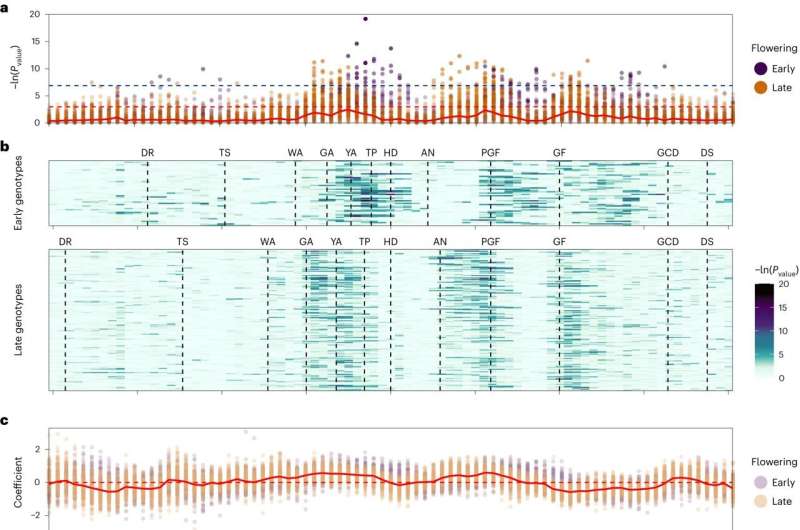This article has been reviewed according to Science X's editorial process and policies. Editors have highlighted the following attributes while ensuring the content's credibility:
fact-checked
peer-reviewed publication
proofread
Insights for crop breeding in the face of climate change

With the aid of innovative statistical methods, researchers explore the complex interplay between life cycle, environmental factors and genetic information using wheat as an example.
Cereal crops such as wheat are sensitive to climate change. Many studies show that their yield decreases as temperatures rise and extreme weather events increase.
A team led by agricultural scientist Prof. Dr. Tsu-Wei Chen from the Humboldt-Universität zuBerlin has developed a new statistical method with which the researchers have been able to demonstrate that there are certain time windows in the life cycle of plants during which environmental variables, such as temperatures or precipitation, have a particularly large influence on later yields.
How high the yield losses are in unfavorable environmental conditions also depends on the genetic make-up of individual cultivars. These findings can, therefore, provide important insights for the future breeding of stress-resistant wheat cultivars. The researchers published their results in Nature Plants.
Climate change is altering cultivation conditions and is already leading to crop failures
Winter wheat is one of the most important crops worldwide and is therefore crucial for food security. There are many factors that determine how large the harvest is at the end, such as the temperature and rainfall levels, the quality of the soil, the type of cultivation, or the cultivar used. Climate change is changing cultivation conditions and is already leading to major crop failures. Farmers have to adapt to this and need new solutions.
"It is already known that winter wheat is very sensitive to high temperatures during the flowering season, from around the end of May to the beginning of June," explains Tsu-Wei Chen. If temperatures increase to over 30 degrees Celsius during this period, the fertilization rate drops rapidly as the pollen gets damaged.
The plant then forms only a few kernels, and the yield remains low. During the life cycle of the wheat plant, there are very many of these special time windows in which it reacts sensitively to various environmental influences. It is difficult to investigate the interaction of environment, genotype and developmental phase during these time windows.
New method makes complex relationships visible
"There are hundreds of wheat cultivars in Germany alone, and all of them have different characteristics," explains Tsu-Wei Chen. "It is almost impossible to characterize all cultivars in detail in field experiments, so as to determine all the strengths and weaknesses and the interactions with the environment."
In order to understand these relationships better nevertheless, the researchers developed a statistical method and applied it to data from field experiments involving 220 different winter wheat cultivars grown at six test sites across Germany for three consecutive seasons.
For each site, each cultivar and each year of the experiment, soil data were determined, along with the determinative yield components, i.e., kernels per spike, spike number, and thousand-kernel weight. The research team combined this data with growth models and selected weather data from the region in question for a total of 81 different time windows per season.
Through this new statistical method, the researchers not only identified all already known sensitive developmental phases, but also ascertained new key moments in the plant life cycle. They were also able to determine which environmental influences are decisive at these times and how strongly the individual cultivars react to them.
For example, they discovered that night time temperature before flowering governs the kernel size, that precipitation still increases the number of ears even after flowering, and that during the late grain filling stage at the end of July, the intensity of the solar radiation influences the weight of the mature kernels.
Breeding stress-resistant cultivars
"We have not only discovered new sensitive time windows, but also instances of stress resistance in certain cultivars," says Tsu-Wei Chen. These findings are particularly important for future breeding, in order to be able to identify cultivars and genetic resources that are less sensitive to environmental fluctuations and can, thus, reliably deliver stable yields.
Furthermore, the novel methods allow cereal crop yields to be predicted under future climate conditions. "Our results open up new avenues for future research and raise several unanswered questions. For example, we need to explore which physiological processes and mechanisms regulate sensitivity and which genetic regions and genes are associated with it," explains the researcher.
More information: Khadija Sabir et al, Stage-specific genotype-by-environment interactions determine yield components in wheat, Nature Plants (2023). DOI: 10.1038/s41477-023-01516-8
Journal information: Nature Plants
Provided by Humboldt-Universität zu Berlin




















